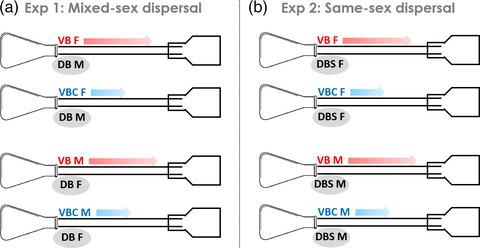当前位置:
X-MOL 学术
›
J. Anim. Ecol.
›
论文详情
Our official English website, www.x-mol.net, welcomes your
feedback! (Note: you will need to create a separate account there.)
Mate‐finding dispersal reduces local mate limitation and sex bias in dispersal
Journal of Animal Ecology ( IF 3.5 ) Pub Date : 2020-07-01 , DOI: 10.1111/1365-2656.13278 Abhishek Mishra 1 , Sudipta Tung 1 , V R Shree Sruti 1 , Sahana Srivathsa 1 , Sutirth Dey 1
Journal of Animal Ecology ( IF 3.5 ) Pub Date : 2020-07-01 , DOI: 10.1111/1365-2656.13278 Abhishek Mishra 1 , Sudipta Tung 1 , V R Shree Sruti 1 , Sahana Srivathsa 1 , Sutirth Dey 1
Affiliation

|
Sex-biased dispersal (SBD) often skews the local sex ratio in a population. This can result in a shortage of mates for individuals of the less-dispersive sex. Such mate limitation can lead to Allee effects in populations that are small or undergoing range expansion, consequently affecting their survival, growth, stability and invasion speed. Theory predicts that mate shortage can lead to either an increase or a decrease in the dispersal of the less-dispersive sex. However, neither of these predictions have been empirically validated. To investigate how SBD-induced mate limitation affects dispersal of the less-dispersive sex, we used Drosophila melanogaster populations with varying dispersal propensities. To rule out any mate-independent density effects, we examined the behavioral plasticity of dispersal in presence of mates as well as same-sex individuals with differential dispersal capabilities. In the presence of high-dispersive mates, the dispersal of both male and female individuals was significantly increased. However, the magnitude of this increase was much larger in males than in females, indicating that the former show greater mate-finding dispersal. Moreover, the dispersal of either sex did not change when dispersing alongside high- or low-dispersive individuals of the same sex. This suggested that the observed plasticity in dispersal was indeed due to mate-finding dispersal, and not mate-independent density effects. Strong mate-finding dispersal can diminish the magnitude of sex bias in dispersal. This can modulate the evolutionary processes that shape range expansions and invasions, depending on the population size. In small populations, mate-finding dispersal can ameliorate Allee effects. However, in large populations, it can dilute the effects of spatial sorting.
中文翻译:

寻找配偶的分散减少了分散中的局部配偶限制和性别偏见
性别偏向散布 (SBD) 通常会扭曲人口中的当地性别比例。这可能导致分散性较低的个体的配偶短缺。这种配偶限制会导致小种群或正在扩大范围的种群中的 Allee 效应,从而影响它们的生存、生长、稳定性和入侵速度。理论预测,配偶短缺会导致分散程度较低的性别的分散增加或减少。然而,这些预测都没有得到经验验证。为了研究 SBD 诱导的配偶限制如何影响分散性较低的性别的分散,我们使用了具有不同分散倾向的黑腹果蝇种群。为了排除任何与配偶无关的密度效应,我们检查了在配偶以及具有不同传播能力的同性个体存在的情况下传播的行为可塑性。在存在高分散性伴侣的情况下,雄性和雌性个体的分散性显着增加。然而,这种增加的幅度在雄性中比在雌性中大得多,表明前者表现出更大的寻找配偶的分散性。此外,当与高分散或低分散的同性个体一起分散时,任何一种性别的分散都没有改变。这表明观察到的扩散可塑性确实是由于寻找配偶的扩散,而不是与配偶无关的密度效应。强烈的寻找配偶传播可以减少传播中性别偏见的程度。这可以调节影响范围扩展和入侵的进化过程,取决于人口规模。在小种群中,寻找配偶的传播可以改善 Allee 效应。但是,在大种群中,它可以淡化空间排序的影响。
更新日期:2020-07-01
中文翻译:

寻找配偶的分散减少了分散中的局部配偶限制和性别偏见
性别偏向散布 (SBD) 通常会扭曲人口中的当地性别比例。这可能导致分散性较低的个体的配偶短缺。这种配偶限制会导致小种群或正在扩大范围的种群中的 Allee 效应,从而影响它们的生存、生长、稳定性和入侵速度。理论预测,配偶短缺会导致分散程度较低的性别的分散增加或减少。然而,这些预测都没有得到经验验证。为了研究 SBD 诱导的配偶限制如何影响分散性较低的性别的分散,我们使用了具有不同分散倾向的黑腹果蝇种群。为了排除任何与配偶无关的密度效应,我们检查了在配偶以及具有不同传播能力的同性个体存在的情况下传播的行为可塑性。在存在高分散性伴侣的情况下,雄性和雌性个体的分散性显着增加。然而,这种增加的幅度在雄性中比在雌性中大得多,表明前者表现出更大的寻找配偶的分散性。此外,当与高分散或低分散的同性个体一起分散时,任何一种性别的分散都没有改变。这表明观察到的扩散可塑性确实是由于寻找配偶的扩散,而不是与配偶无关的密度效应。强烈的寻找配偶传播可以减少传播中性别偏见的程度。这可以调节影响范围扩展和入侵的进化过程,取决于人口规模。在小种群中,寻找配偶的传播可以改善 Allee 效应。但是,在大种群中,它可以淡化空间排序的影响。









































 京公网安备 11010802027423号
京公网安备 11010802027423号